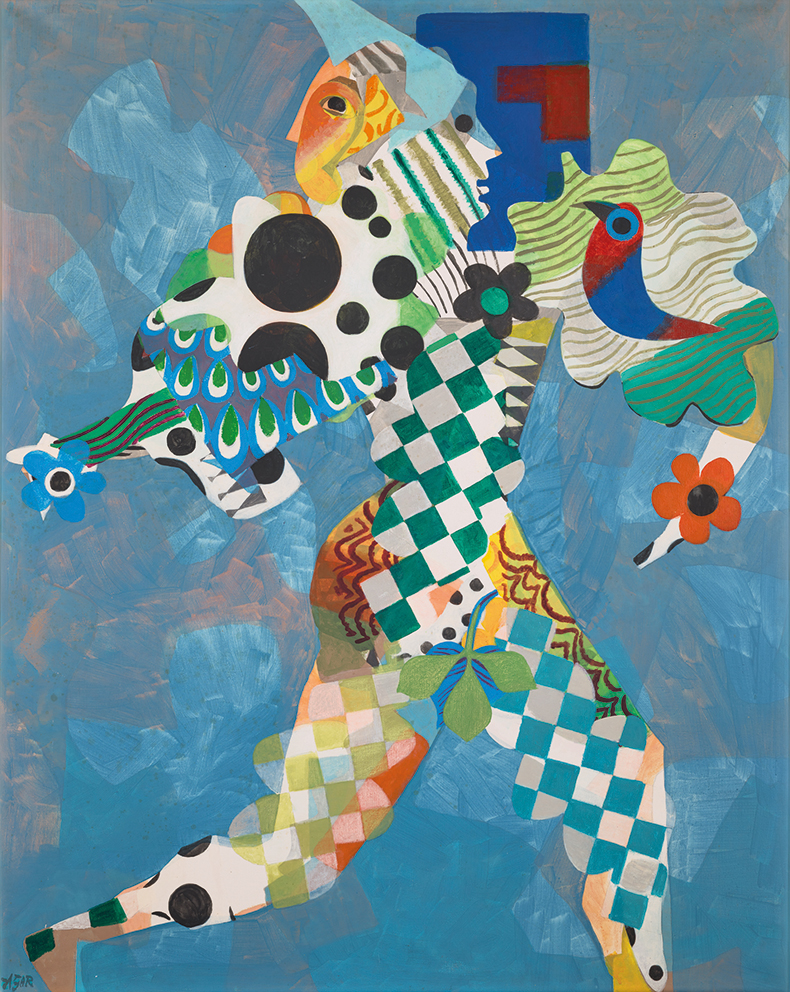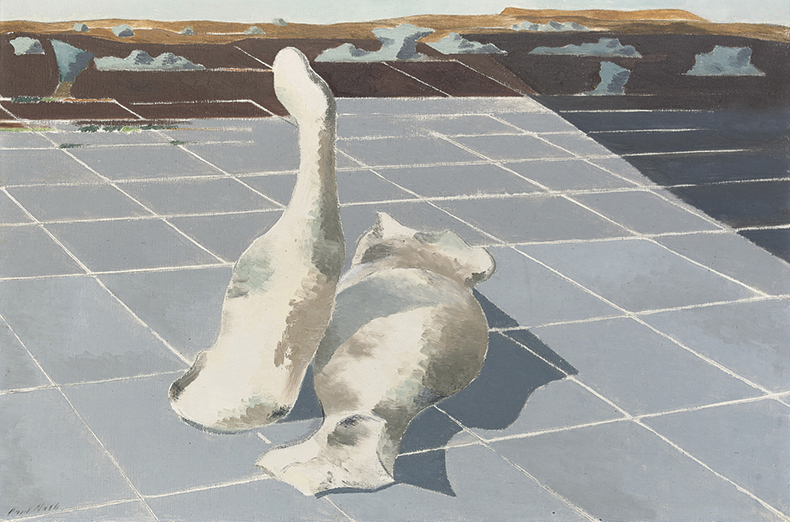From the April 2022 issue of Apollo. Preview and subscribe here.
Introducing the exhibition, ‘Surrealism Beyond Borders’ (until 29 August), Tate Modern declares on its website that ‘Surrealism is not a style – but a state of mind.’ Currently it seems to be one shared by all of us. In early March, Sotheby’s transformed its headquarters in London to look like a Magritte painting, ahead of its sale on 2 March of the artist’s L’empire des lumières (1961) for a record-breaking £59.4m (with fees, against a guarantee of £45m). A fortnight later the auction house launched its first dedicated Surrealism sale in Paris. Bonhams held its second ‘Mind’s Eye: Surrealist Sale’ on 8 March, which pulled together Surrealist works from across a range of departments. While all three sales gave precedence to European artists, British Surrealism is also seeing a surge of interest.
As recent exhibitions have argued – in particular, ‘British Surrealism’ at the Dulwich Picture Gallery in 2020 – British Surrealism was not merely an offshoot of the movement in Europe, but drew on native traditions that stretch back at least as far as the 17th century, distinguished above all by a deeply felt affinity with nature and the British landscape, both inland and coastal. The curator of the show, David Boyd Haycock, has argued that even in the pre-First World War paintings of Paul Nash ‘there’s an element of surrealism before the existence of the word’. Last month, ‘When Dreams Confront Reality: The Sherwin Collection’– a selection of highlights from perhaps the most important privately owned collection of British Surrealist works – opened at the Hepworth Wakefield (until January 2023). André Breton’s First Manifesto of Surrealism (1924), which emphasised the role of psychic automatism and dreams in the creation of Surrealist artworks, cited British influences as well as French. But by 1929, Breton had transformed Surrealism into something distinctly urban and anarchic, demanding a directness of political engagement at odds with the mindset of many British artists.
It was, by contrast, the first London exhibition of Giorgio de Chirico’s dream-like paintings in 1928 that inspired Nash’s shift to determinedly Surrealist works. In 1933, Nash founded Unit One – an influential group that included Henry Moore, John Armstrong, Edward Burra, Ben Nicholson, John Bigge, Edward Wadsworth and Tristram Hillier, all of whose work demonstrated elements of the surreal. By the time of the ‘International Surrealist Exhibition’ in London (1936), there were, alongside the Unit One artists, the British painters Eileen Agar, John Banting, Julian Trevelyan, Roland Penrose, Reuben Mednikoff, Graham Sutherland and Grace Pailthorpe. Other artists whose work had strong Surrealist qualities include Marion Adnams, Ithell Colquhoun, Edith Rimmington, Emmy Bridgwater, Conroy Maddox and John Tunnard. For many of these, the impact of Surrealism on their work continued long after the movement’s heyday in the 1930s.
Harlequin (1968), Eileen Agar. Christie’s London, £63,000

The contribution of women to British Surrealism has recently become better appreciated, through the work of the art historian Sacha Llewellyn of Liss Llewellyn dealership, among others. The star lot in Bonhams’ first ‘Mind’s Eye’ sale last March was Leonora Carrington’s painting Operation Wednesday (1969), which fetched £682,750 (est. £300,000–£500,000); this month, Bonhams found an artist record of £14,000 for Grace Pailthorpe’s Untitled of 1941 (est. £1,500–£2,500). On 29 September 2021, Ithell Colquhoun’s explosive painting Battle Fury of Cuchullin (1949) was chased at Bonhams to £37,750 – a new record for the artist, and more than 10 times the top estimate of £3,000. Agar’s vibrant Harlequin (1968) soared to £63,000 at Christie’s London on 2 March this year while a later work, Return of Europa (1971), fetched £57,960 (both against estimates of £12,000–£18,000). While she expressed ambivalence about the Surrealist movement, Agar, who was included in the ‘International Surrealist Exhibition’ in 1936, once said that ‘we walk on two legs, and for me, one is abstract, the other surreal – it is point and counterpoint.’
Encounter in the Afternoon (1936), Paul Nash. Christie’s London, £937,250

The highest prices found at auction, however, continue to be for works by male artists. Paul Nash’s record stands at £937,250 for his uncanny Encounter in the Afternoon (1936), sold at Christie’s London in 2008 (est. £120,000–£180,000). Edward Burra’s complex pencil, ink and watercolour painting War in the Sun (1938) – an eerie, impassioned response to the Spanish Civil War – sold for just over £1.8m (est. £1.8m–£2.5m) at Sotheby’s London last June. Julia Fischel, a specialist at Sotheby’s London, comments, ‘There are so few pure Surrealist pieces in British Surrealism.’ But most collectors interested in these artists (aside from Nash, whose First World War paintings are his most sought after) are looking for works with Surrealist elements –‘found objects on the beach, machines changing into animals, shape-shifting, artists finding these uncanny traces in ancient landscapes.’ Currently the market is dominated by British collectors – ‘but for the best [pieces] it is international’, Fischel adds. ‘The Burra was bought by an Asian buyer. We are at the beginning of a change in interest at auction.’
One problem is supply. Florence Evans, director of the Fine Art Society (FAS) in London, says, ‘We haven’t had an early Surrealist work for a while.’ As the market for modern British art has flourished, so has demand grown for Surrealist works. A display at FAS of John Armstrong’s work last year did include some early, though not obviously Surrealist pieces from the 1930s; Evans suggests that while the later works represent a significant shift in the way Armstrong painted, they ‘still have relevance’ in the context of British Surrealism. Matthew Travers of Piano Nobile gallery in London reports strong interest from institutions in France and elsewhere, aware of their weaknesses in this area. ‘Great British Surrealist works are rare things,’ Travers says – though he also emphasises the connections between Surrealism in Britain and on the Continent.
The Pointing Finger (1933), Edward Burra. Lefevre Fine Art, in the region of £400,000

Alexander Corcoran of Lefevre Fine Art suggests that one difficulty in appreciating the full importance, internationally, of British Surrealism is that the most significant artists – Nash, Burra, Moore, Sutherland – are not generally considered to be Surrealists and indeed had reservations about the movement as characterised by Breton. So the Surrealist elements of their work are often misunderstood. Corcoran argues that British art, more broadly, is too often looked at in isolation and not in an international context. He has available an early work by Edward Burra, The Pointing Finger (1933) – a fantastical watercolour painted before Burra’s vision of mankind was darkened by the Spanish Civil War, when a necessarily grimmer strain of Surrealism emerged in his work.
From the April 2022 issue of Apollo. Preview and subscribe here.



